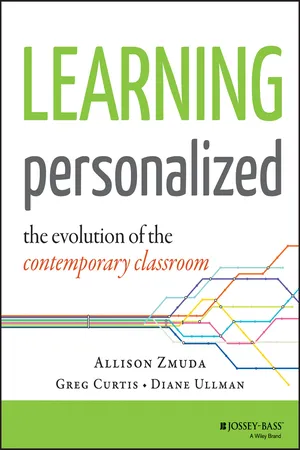
Learning Personalized
The Evolution of the Contemporary Classroom
- English
- ePUB (mobile friendly)
- Available on iOS & Android
Learning Personalized
The Evolution of the Contemporary Classroom
About this book
A real-world action plan for educators to create personalized learning experiences
Learning Personalized: The Evolution of the Contemporary Classroom provides teachers, administrators, and educational leaders with a clear and practical guide to personalized learning. Written by respected teachers and leading educational consultants Allison Zmuda, Greg Curtis, and Diane Ullman, this comprehensive resource explores what personalized learning looks like, how it changes the roles and responsibilities of every stakeholder, and why it inspires innovation. The authors explain that, in order to create highly effective personalized learning experiences, a new instructional design is required that is based loosely on the traditional model of apprenticeship: learning by doing.
Learning Personalized challenges educators to rethink the fundamental principles of schooling that honors students' natural willingness to play, problem solve, fail, re-imagine, and share. This groundbreaking resource:
- Explores the elements of personalized learning and offers a framework to achieve it
- Provides a roadmap for enrolling relevant stakeholders to create a personalized learning vision and reimagine new roles and responsibilities
- Addresses needs and provides guidance specific to the job descriptions of various types of educators, administrators, and other staff
This invaluable educational resource explores a simple framework for personalized learning: co-creation, feedback, sharing, and learning that is as powerful for a teacher to re-examine classroom practice as it is for a curriculum director to reexamine the structure of courses.
Frequently asked questions
- Essential is ideal for learners and professionals who enjoy exploring a wide range of subjects. Access the Essential Library with 800,000+ trusted titles and best-sellers across business, personal growth, and the humanities. Includes unlimited reading time and Standard Read Aloud voice.
- Complete: Perfect for advanced learners and researchers needing full, unrestricted access. Unlock 1.4M+ books across hundreds of subjects, including academic and specialized titles. The Complete Plan also includes advanced features like Premium Read Aloud and Research Assistant.
Please note we cannot support devices running on iOS 13 and Android 7 or earlier. Learn more about using the app.
Information
Chapter 1
Making the Case for Personalized Learning
I’m constantly going through the motions down a path that has been chosen for me by others. When is it going to be my turn?
Disconnect between Traditional School and Preparation for a Postsecondary World
- Designing customized learning experiences around what learner(s) are fascinated by, rather than marching through predetermined topics and texts
- Creating a collaborative classroom and school culture where students own the learning process because they set a goal, do the work, seek out feedback, improve their performance, and document their accomplishments
- Breaking down traditional classroom walls to connect learners to experts and audiences far beyond the schoolhouse door
- Increasing our focus on contemporary literacies (digital, media, and global) and ways to work (social production, social networks, media grids, semantic web, nonlinear learning), integrating them into our design and instructional practices
- Persisting when obstacles interfere with progress and providing additional time to produce quality work
The Power of a Student-Driven Model
- Personalized learning is a better way to attain current learning outcomes. We’re well aware that teachers and schools are surrounded by a host of expectations focused on attaining content. This is reality; we can’t wish it away. We simply start with the premise that personalized learning is a sound and effective way to learn. Compared to the outdated approaches of transmission, retention, and recall, personalized learning allows for deeper, more lasting learning in an engaging and relevant environment. But personalization is not just a better mousetrap to achieve the same goals as past models of teaching and learning, nor is it simply a new delivery vehicle that achieves the same goals.
- Personalized learning is a better way to grow children. We believe that education must strive to achieve more transformational outcomes alongside the achievement of existing or more traditional ones. We don’t teach subjects—we teach children and young adults. Personalized learning is the best way we know to grow these people into the best versions of themselves, with all of the skills and mindsets needed to succeed and contribute to our shared future.
Table of contents
- Cover
- Title Page
- Copyright
- Dedication
- Foreword
- Acknowledgments
- About the Authors
- Introduction
- Chapter 1: Making the Case for Personalized Learning
- Chapter 2: The Aims of Contemporary Schooling
- Chapter 3: The Design of a Student-Driven Learning Experience
- Chapter 4: Tasks That Demonstrate Personalized Learning Evolution in Practice
- Chapter 5: What Personalized Learning Looks Like at the Instructional Level
- Chapter 6: What Personalized Learning Looks Like at the Systems Level
- Chapter 7: Leading the Change for Personalized Learning
- The Conclusion of the Era of “One-Size-Fits-All Schooling”
- Appendix A: Additional Resources for Chapters 1–3
- Appendix B: Additional Resources for Chapter 4
- Appendix C: Additional Resources for Chapters 5 and 6
- Appendix D: Additional Resources for Chapter 7
- Index
- End User License Agreement